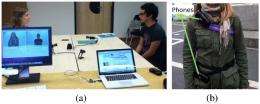(a) the setup of the interview room. (b) the setup of data collection. Image from "StressSense: Detecting Stress in Unconstrained Acoustic Environments using Smartphones", Hong Lu et al.
(Phys.org) -- Computer scientists working in a range of departments, from pervasive computing to mobile computing to sensors, will converge in Pittsburgh for the 14th International Conference on Ubiquitous Computing (Ubicomp 2012) on September 5 through 8. They will learn more there about a team’s software that can recognize stress from vocal patterns. The researchers wanted to see if they could successfully train a system to pick up stress through a person's voice. Their paper, “StressSense: Detecting Stress in Unconstrained Acoustic Environments using Smartphones,” authored by Hong Lu, Mashfiqui Rabbi, Gokul T. Chittaranjan, Denise Frauendorfer, Marianne Schmid Mast, Andrew T. Campbell, Daniel Gatica-Perez, and Tanzeem Choudhury, details their success.
“We propose StressSense for unobtrusively recognizing stress from human voice using smartphones,” say the authors, and they believe they can demonstrate that their StressSense classifier “can robustly identify stress across multiple individuals in diverse acoustic environments.”
Their system is trained first to recognize someone's unstressed voice. StressSense compares this recording to its preprogrammed knowledge of stress-caused physiological changes, such as faster speech and clipped frequency spectrum.
The study authors, including Hong Lu of Intel in Santa Clara, California, found the prototype's stress-recognition accuracy to be 81 per cent indoors and 76 per cent outdoors.
Baseline voice rates for a group of people were gathered. According to their system, the person is told first to relax and read a three-minute passage from a book into the phone. Participants were subsequently placed in stressful job interviews to test the system. The study group totaled 14. Thirteen participants were undergraduate students in fields such as geology, psychology, biology, and law. One participant was a PhD student. Audio data was collected using Nexus One phones at 8kHz 16 bit PCM using a custom Android program that runs in the background, according to the paper.
The researchers next plan to design, deploy, and evaluate a StressSense Android app. The inevitable question is what good will it do to be told by one’s own smartphone to chill out. The team is confident that the app carries real and practical benefits. Lu said the software has the potential to raise user awareness of stressful events and to help cope.
The interest in voice analysis to recognize stress is not new. The study authors point to pioneering work in 1968 when amplitude, fundamental frequency, and spectrograms were analyzed for speech under task-induced stress . They also noted a body of research on stress detection from speech centered around the Speech Under Simulated and Actual Stress (SUSAS) dataset.
“Evidence from experiments with SUSAS suggests that pitch plays a prominent role in stress. Other important features are those using energy, spectral characteristics of the glottal pulse, and phonetic variations (speaking rate) and spectral slope.”
As for their own study findings, the team pointed out four contributions of their paper. They experimentally show that 1) stress from human voice can be detected using smartphones in indoor and outdoor conversational data; that 2) a universal stress model can be adapted to specific individual users; 3) a stress model can be adapted to unseen environments, lowering the cost of training stress models for different scenarios; and 4) the proposed stress classification pipeline can run in real-time on off-the-shelf Android smartphones.
More information: publications.idiap.ch/download … /Lu_UBICOMP_2012.pdf
© 2012 Phys.org



.jpg)

















